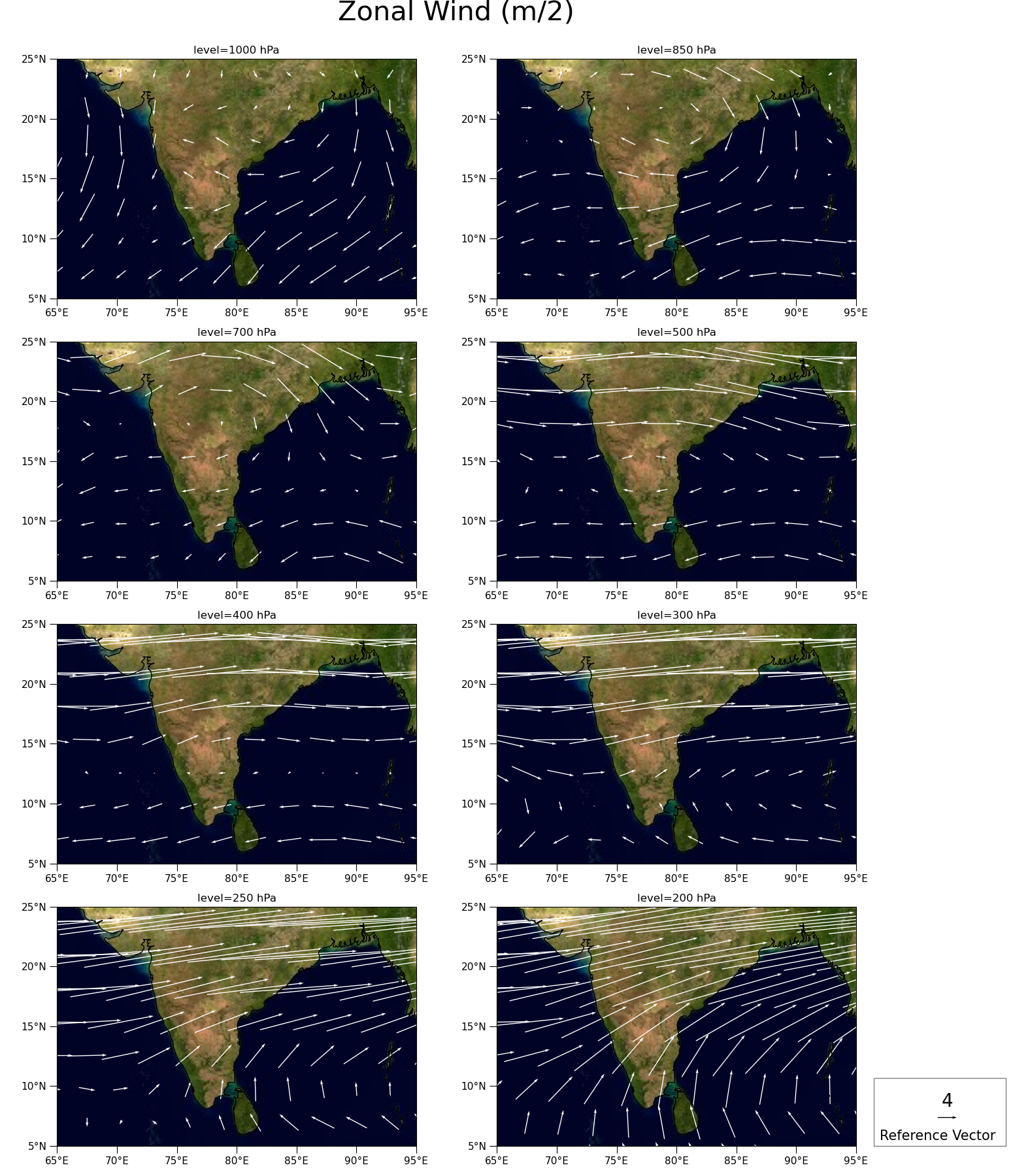Note
Go to the end to download the full example code
NCL_panel_31.py#
- This script illustrates the following concepts:
Paneling 8 plots on a page
Adding a common title to paneled plots
Overlaying an image onto a map
Adding a vector field to a map
- See following URLs to see the reproduced NCL plot & script:
Original NCL script: https://www.ncl.ucar.edu/Applications/Scripts/panel_31.ncl
Original NCL plot: https://www.ncl.ucar.edu/Applications/Images/panel_31_lg.png
Import packages:
import numpy as np
import matplotlib.pyplot as plt
import cartopy.crs as ccrs
import xarray as xr
import geocat.viz as gv
import geocat.datafiles as gdf
Read in Data:
# Read in the image file
fname = gdf.get('image_files/EarthMap.jpg')
img = plt.imread(fname)
# Read in the vector data using xarray
ds = xr.open_dataset(gdf.get("netcdf_files/uvt.nc")).isel(time=0)
# Select zonal and meridional wind
U = ds.U
V = ds.V
# Select latitude and longitudes
lat = ds.lat
lon = ds.lon
Plot:
# Create a figure and axes
fig, axs = plt.subplots(ncols=2,
nrows=4,
figsize=(15.5, 18),
subplot_kw={'projection': ccrs.PlateCarree()})
# Define pressures and reshape to match subplot layout (4 rows, 2 columns)
levs = np.array([1000, 850, 700, 500, 400, 300, 250, 200])
pressure = np.reshape(levs, (4, 2))
# Define image extent. This image is of the entire globe, so extent covers all latitudes and longitudes
img_extent = (-180, 180, -90, 90)
# Loop through each axes and plot
# Loop through each row
for i in range(4):
# Loop through each column
for j in range(2):
# Set axes
ax = axs[i][j]
# Set extent of the map
ax.set_extent([65, 95, 5, 25])
# add the image. The "origin" of the image is in the upper left corner
ax.imshow(img,
origin='upper',
extent=img_extent,
transform=ccrs.PlateCarree())
ax.coastlines(resolution='50m', color='black', linewidth=1)
# Add vectors onto the plot
Q = ax.quiver(lon,
lat,
U.sel(lev=pressure[i][j]),
V.sel(lev=pressure[i][j]),
color='white',
pivot='middle',
width=.0025,
scale=75)
# Use geocat-viz utility function to format lat/lon tick labels
gv.add_lat_lon_ticklabels(ax=ax)
# Use geocat-viz utility function to customize tick marks
gv.set_axes_limits_and_ticks(ax,
xlim=(65, 95),
ylim=(5, 25),
xticks=range(65, 100, 5),
yticks=range(5, 27, 5))
# Customize ticks and labels
ax.tick_params(labelsize=11, length=8)
# Add title to the axes
ax.set_title(f'level={pressure[i][j]} hPa')
# Add title to the figure
plt.suptitle("Zonal Wind (m/2)", fontsize=30, y=1, x=0.45)
# Draw legend for vector plot
ax.add_patch(
plt.Rectangle(
(96.5, 5), # xy location of rectangle
11, # width
5.7, # height
facecolor='white',
edgecolor='grey',
clip_on=False) # allow rectangle to be visible beyond axes
)
ax.quiverkey(
Q, # the quiver instance
0.935, # x position of the key
.05, # y position of the key
4, # length of the key
'4', # label for the key
labelpos='N', # position the label to the 'north' of the arrow
color='black', # arrow color
coordinates='figure',
fontproperties={'size': 20},
labelsep=0.1, # Distance between arrow and label
)
# Add text to key
plt.text(97, 5.5, "Reference Vector", fontsize=15)
# Show the plot
plt.tight_layout() # Auto adjusts padding on edge of figure
plt.show()

Total running time of the script: (0 minutes 3.396 seconds)